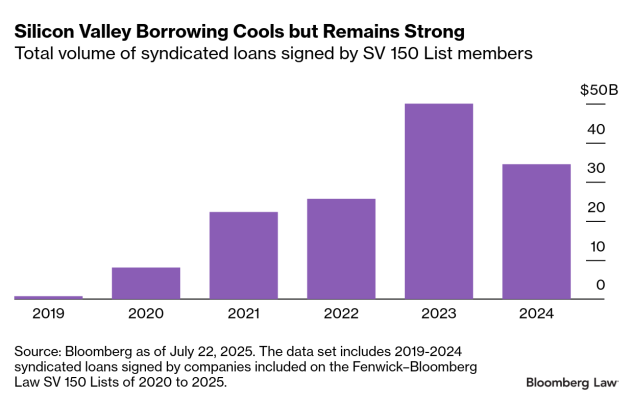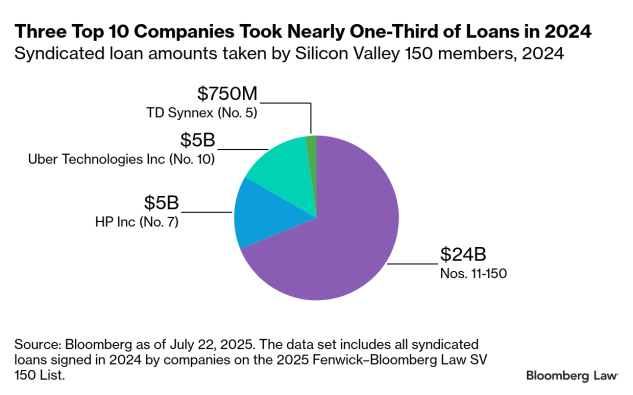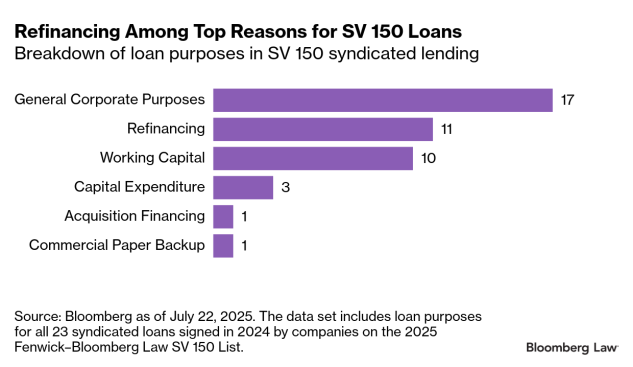This analysis is part of a series covering the 2025 Fenwick–Bloomberg Law SV 150 List, an annual resource developed by Bloomberg Law and technology and life sciences law firm Fenwick. The SV 150 List ranks the largest public technology and life sciences companies in Silicon Valley by revenue. Additional analyses in the series are listed at the end of this article.
The syndicated loan activity of Silicon Valley’s top-earning tech and life science companies fell to $34.4 billion last year from 2023’s record-setting high of $49.9 billion, according to the 2025 Fenwick–Bloomberg Law SV 150 List of the largest of these companies. The loans remained well above historical volumes, signaling that these companies continue to rely on the syndicated loan market as a key source of financing for growth, innovation, and capital planning.
Last year’s syndicated loan activity for this group of companies was 46 times higher than 2019’s $750 million. In this context, the 2024 numbers suggest a stabilization of borrowing activity rather than a retraction—a recalibration following an exceptional year, with loan volumes settling into a higher post-pandemic baseline.
The 2023 spike was largely fueled by Broadcom Inc.'s $30.4 billion financing for its VMware acquisition. In contrast, the $34.4 billion borrowed in 2024 was spread across the SV 150 companies, with the largest individual loan volume—that of HP Inc—totaling $5 billion.
Only three companies among this year’s top 10 on the SV 150 list took loans in 2024, but those three collectively borrowed $10.8 billion, accounting for 31% of the syndicated loan volumes for 2024. In comparison, the top 10 on last year’s list accounted for a whopping 78% of 2023’s syndicated loan volume. However, Broadcom’s 2023 lending volume was a significant outlier that heavily inflated the top 10’s share of SV 150 loan volume in 2023, which was almost double that of 2024.
Interestingly, the companies in this year’s top 10 that took out syndicated loans experienced only marginal increases in market capitalization. TD SYNNEX Corp saw a 0.4% increase; Uber Technologies Inc rose by 0.2%; and HP Inc grew 2.6%. This suggests that for the largest firms, increased borrowing didn’t necessarily correlate with noteworthy gains in market value. Reasons for this may include market caution, limited short-term returns on deployed capital, or broader macroeconomic headwinds such as inflation and supply chain disruptions dampening investor sentiment for those companies.
Loan Purposes
The top three reasons for SV 150 borrowing last year were to support operations (appeared in 17 deals), refinance existing debt (11 deals), and acquire working capital (10 deals).
While most loans were tied to multiple purposes, “refinancing” featured in 42% of the loan transactions, reflecting a strategic focus on financial resilience. This notable share of lending activity for refinancing purposes was likely influenced by several factors. Companies may have sought to:
- extend maturities in anticipation of higher interest rates,
- replace more expensive or restrictive legacy debts, or
- strengthen balance sheets in response to volatile market conditions.
Last year’s syndicated loans data underscores how important a component of financial strategy they’ve become for Silicon Valley’s top companies—not just for the largest players, but for a broader segment of the tech and life sciences industries. And as these companies continue to diversify their financing strategies amid evolving macroeconomic conditions, the broadly syndicated loan market is poised to play an even more central role in shaping corporate finance strategies of Silicon Valley leaders.
If you are having trouble viewing this interactive graphic, please enable third-party cookies on your browser. Terminal users, please click here to view this interactive graphic.
In other analysis articles covering the results of the 2025 Fenwick–Bloomberg Law SV 150 List:
- Boebin Park spotlights the top 10 companies on this year’s list, including their M&A activity over the past year.
- Preston Brewer analyzes how the 2025 list’s IPOs compare to previous years and to the market at large.
- Stephanie-Solange Campbell introduces the 14 Silicon Valley companies that are new arrivals to the 2025 list.
Bloomberg Law subscribers can find related content on our Transactional Intelligence Center resource.
If you’re reading this on the Bloomberg Terminal, please run BLAW OUT in order to access the hyperlinked content, or click here to view the web version of this article.
To contact the reporter on this story:
To contact the editor responsible for this story:
Learn more about Bloomberg Law or Log In to keep reading:
See Breaking News in Context
Bloomberg Law provides trusted coverage of current events enhanced with legal analysis.
Already a subscriber?
Log in to keep reading or access research tools and resources.




